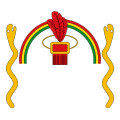Inca empire
| Inca Empire | ||||||||||||||
| Tawantinsuyu (Quechua) | ||||||||||||||
|
||||||||||||||
|
The Inca Empire at its greatest extent
|
||||||||||||||
| Capital |
Cusco (1438–1533) |
|||||||||||||
| Languages | Quechua (official), Aymara, Puquina, Jaqi family, Muchik and scores of smaller languages. | |||||||||||||
| Religion | Inca religion | |||||||||||||
| Government | Divine, Absolute Monarchy | |||||||||||||
| Sapa Inca | ||||||||||||||
| • | 1438–1471 | Pachacuti | ||||||||||||
| • | 1471–1493 | Túpac Inca Yupanqui | ||||||||||||
| • | 1493–1527 | Huayna Capac | ||||||||||||
| • | 1527–1532 | Huáscar | ||||||||||||
| • | 1532–1533 | Atahualpa | ||||||||||||
| Historical era | Pre-Columbian | |||||||||||||
| • | Pachacuti created the Tawantinsuyu | 1438 | ||||||||||||
| • | Civil war between Huáscar and Atahualpa | 1529–1532 | ||||||||||||
| • | Spanish conquest led by Francisco Pizarro | 1533 | ||||||||||||
| • | End of the last Inca resistance | 1572 | ||||||||||||
| Area | ||||||||||||||
| • | 1527 | 2,000,000 km² (772,204 sq mi) | ||||||||||||
| Population | ||||||||||||||
| • | 1527 est. | 10,000,000 | ||||||||||||
| Density | 5 /km² (12.9 /sq mi) | |||||||||||||
|
||||||||||||||
| Today part of |
|
|||||||||||||
| Historical states in present-day Argentina |
|
|---|---|
 |
|
| more |
The Inca Empire (Quechua: Tawantinsuyu, lit. "The Four Regions"), also known as the Incan Empire and the Inka Empire, was the largest empire in pre-Columbian America, and possibly the largest empire in the world in the early 16th century. The administrative, political and military center of the empire was located in Cusco in modern-day Peru. The Inca civilization arose from the highlands of Peru sometime in the early 13th century. Its last stronghold was conquered by the Spanish in 1572.
From 1438 to 1533, the Incas used methods including conquest and peaceful assimilation, to incorporate a large portion of western South America, centered on the Andean mountain ranges. At its largest, the empire joined Peru, large parts of modern Ecuador, western and south central Bolivia, northwest Argentina, north and central Chile and a small part of southern Colombia into a state comparable to the historical empires of Eurasia. Its official language was Quechua. Many local forms of worship persisted in the empire, most of them concerning local sacred Huacas, but the Inca leadership encouraged the worship of Inti—their sun god—and imposed its sovereignty above other cults such as that of Pachamama. The Incas considered their king, the Sapa Inca, to be the "son of the sun."
...
Wikipedia


